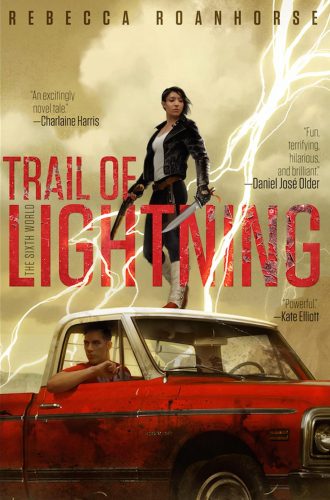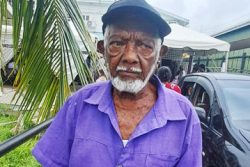In early August, the Intergovernmental Panel on Climate change (IPCC) released an updated report on scientists’ current understanding of the state of global warming and its implications for our present and future. This review of current climate literature is a sobering warning for our future if we do nothing to mitigate this ongoing disaster by holding the culpable corporations responsible for the ways they have polluted the globe.
Indigenous peoples from around the world have been on the frontlines of climate and environmental activism, from the Sioux at the Dakota Access Pipeline protests to our very own wardens and trackers working in Iwokrama, to indigenous activists in Brazil doing their best to preserve the Amazon forests.

Since September is Amerindian Heritage Month here in Guyana, I wanted to examine a book by an Indigenous woman, which centres around climate change and climate disasters. Rebecca Roanhorse’s award-winning Trail of Lightning — an indigenous climate-fantasy novel — does just that.
“When I was fourteen, before the Big Water, when TVs still worked and the melting of polar ice was generating reports of record storms from Florida to Main, and the flooding along the Eastern Seaboard made Hurri-cane Sandy look like the female rain of a light summer shower, Coyote came to me.” (p.88)
We learn three things when we meet Maggie Hoskie in the opening of Trail of Lightning. First, she is a monster hunter and former protégée of the immortal Neizghání. She has clan powers that manifest to make her a gifted and efficient berserker-like killer, which — along with her abrasive personality — make people fear her. Second, she lives in the New Mexico Navajo Reservation or Dinétah. Third, she is the survivor of the Big Water, the hybrid climate change/seismic catastrophe that drowned two-thirds of the North American continent, forming a new coastline that stretched from San Antonio in Texas up to Sioux Falls in South Dakota. Dinétah is lucky, having survived the initial Big Water event, but now legendary heroes, gods and strange monsters are roaming the land once more.
When one of these monsters kidnaps a young girl from the small town of Lukachukai, the residents summon Maggie as their last resort. Maggie takes the job — albeit reluctantly — tracks the unnamed monster into the mountains and slays it but is unable to save the girl. Haunted by her failure, she makes her way to Tse Bonito to consult with Grandpa Tah, a medicine man and old friend. Tah doesn’t have the answers for her, but he does refer her to his grandson, Kai Arviso, the stylish, sweet-talking young man who seems out of place in the post-apocalyptic world.
As Maggie and Kai travel across the reservation to hunt for clues about the monster, they meet more gods, make more friends, slowly unravel the mysteries of the monsters and uncover the truths about themselves and their place in Dinétah’s history in the making.
A memorable cast
I think one of the best things about Roanhorse’s novel is the memorable cast of characters she created. Both the main and supporting characters in Trail of Lightning are fascinating and unique, and they help to teach us a little bit about modern reservation life in the US and about the Navajo legends and stories as well.
Maggie is a judgmental, brawny young woman ready to solve every problem she encounters with her hunting knife and shotgun. Kai is the total opposite, a silver-tongued diplomat with a good memory for ancestral stories and an eye for finer details. While their relationship started off a bit rocky, their chemistry grows throughout the novel, and they bring out the best in each other in the strangest ways. They are supported and antagonised by many people throughout their journey across Dinétah, the Goodacre Family and the Law Dogs respectively, and Roanhorse managed to render these interactions beautifully, making the novel a fast-paced, action-packed read.
Apart from them, the supporting characters they meet were also beautifully rendered. I really loved Coyote/Ma’ii, Maggie’s supernatural aide who helps her on her quest to find the origins of the monsters plaguing Dinétah. He’s a knowledgeable trickster who keeps both Maggie and the reader on edge through-out the novel, as we are never quite sure what his endgame is.
My only personal wish was that we were able to see more of Neizghání. Maggie mentions him a lot throughout the novel and his shadow looms over much of it as Maggie frequently references him as her mentor, or the people around her do. However, we only see him in action twice for very brief and somewhat disappoint-ing moments. I am not sure if Maggie just had an unhealthy obsession with Neizghání or if Roanhorse is setting us up for his reappearance and a more involved role in the sequel.
Climate disaster as a rebirth
[Kai] pushes his aviators up off his face, squints into the sun.
“Seems anywhere there’s a natural resource, there’s someone willing to hoard it for themselves to make more money than they can spend.”
I think of the Protectors, the people who fought the multi-nationals in the Energy Wars and lost. Until Earth herself stepped in and drowned them all regardless of personal politics.
“Water is life,” I say.
“And you can’t drink oil,” he replies, the old Protector slogan we all learned as kids. (p. 54).
Mostly, however, I was fascinated by the undercurrent of climate change rhetoric throughout the novel and the way the native stories seem to be prophetic in the world she has created. Roanhorse chose to speculate about what indigenous life would be like if climate change went unchecked and the worst of climate change and seismic disasters became our reality in the near future. The world is post-apocalyptic, yes, and every character in the book was either directly or indirectly affected by the Big Water.
Despite this grim reality, there is a hopefulness in this new Dinétah. “I had forgotten that the Diné had already suffered their apocalypse over a century before,” Maggie says in page 23 in reference to the indigenous genocide across North America, “This wasn’t our end. This was our rebirth.”
Throughout the novel, we see the way that many of the Diné used the fallout from the Energy Wars and Big Water to immerse themselves in a cashless society based mostly on trade and favours, and how the manifestation of clan powers made ordinary people powerful in often strange but useful ways.
The Big Water caused a supernatural awakening in the land, which brings the Diné both triumph and woe.
“I have lived many lives in many worlds,” Ma’ii says, “even before Changing Woman made the five-fingered people, and in them all the worlds have come to an end in a great flood. Each time the waters rose so high on all sides that we thought the cresting waves were the tips of the snowy mountains. This last flood, the one you call the Big Water, ended the Fifth World and began the Sixth. It opened the passage for those like myself to return to the world.” Coyote explaining the Big Water to Kai (p.101)
With the return of the Bik’e’áyéeii, the legendary beings like Ma’ii the Coyote and Mósí the Cat, power literally returns to Dinétah now that the power that kept them suppressed has long drowned in the Big Water. This power manifests in some people developing clan powers like “living arrow” in the case of Maggie or “sticking-up ears” in the case of a guard with unnaturally keen hearing that they encounter on their journey. Maggie and Kai debate on whether these powers are blessings or curses, and Roanhorse leaves it up for the reader to decide.
Conclusion
I really liked Trail of Lightning and look forward to reading the next instalment in her Sixth World series. I found it fascinating and in keeping with many of the trends in indigenous sci-fi and fantasy that I have read over the last year which suggest that power will only return to these groups when the powers that be see their end.
It’s one of the few books that I have read that featured an almost exclusively indigenous cast and I would love to read more books like it. Roanhorse’s characters were interesting and memorable, and I found myself laughing, raging, and mourning with them. The worldbuilding was so subtle at times, especially the references to the extent of the effects of climate change, that I found myself doing extra research to ensure that I caught the details I missed in my readings.
Want to read more indigenous speculative fiction? Here are my recommendations:
1. Storm of Locusts by Rebecca Roanhorse
2. Love After the End edited by Joshua Whitehead
3. Prism Stalker by Sloane Leong
4. Robopocalypse by Daniel H. Wilson
5. The Only Good Indians by Stephen Graham Jones






